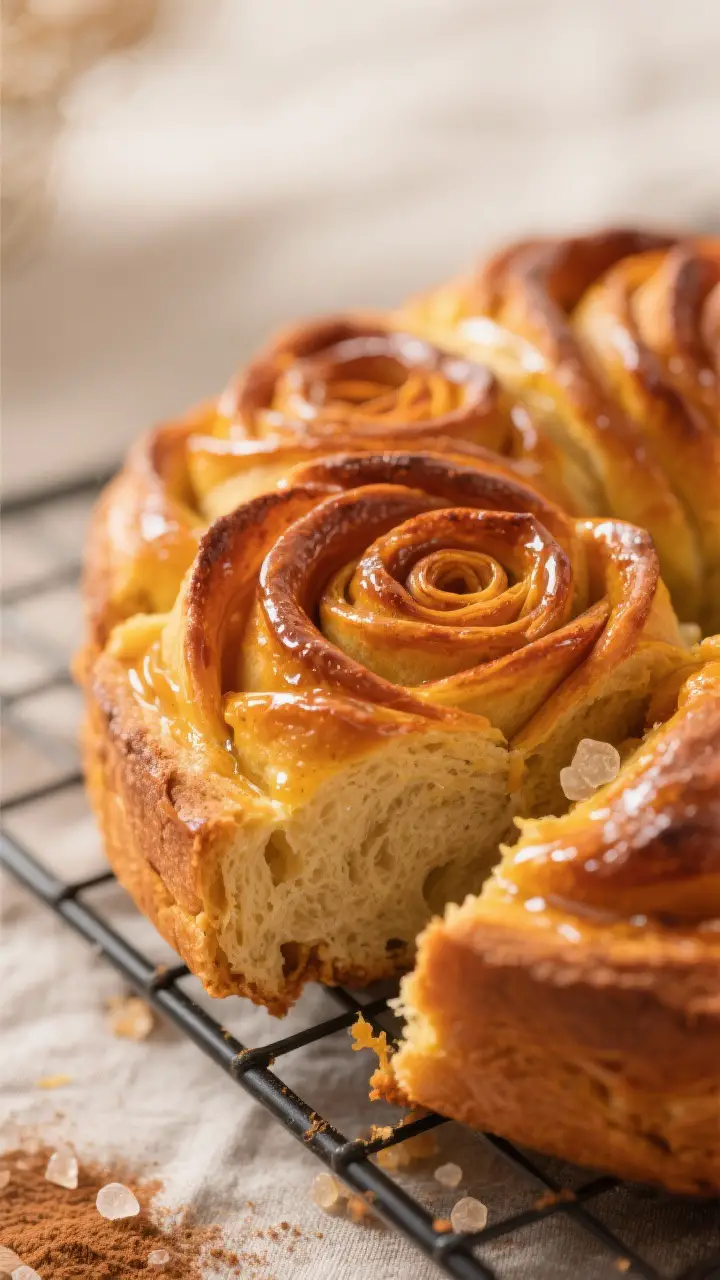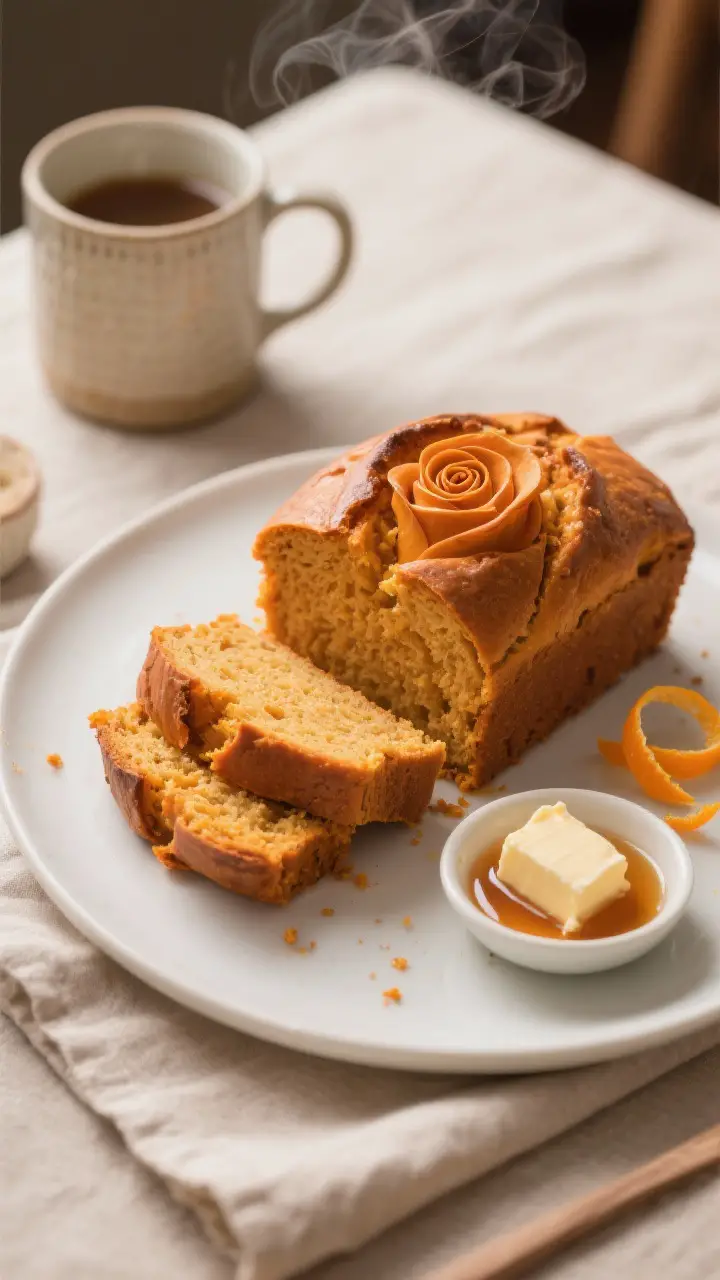Pumpkin Rose Bread is the kind of recipe that makes your kitchen smell like fall and your table look like a celebration. It’s soft, lightly sweet, and shaped like a blooming rose—simple enough for a weekend bake, but impressive enough for guests. The pumpkin adds gorgeous color and moisture, while rosewater brings a gentle floral aroma that’s subtle, not overwhelming.
If you love cozy baking with a touch of elegance, this loaf hits the spot. It’s delicious plain, with a smear of butter, or lightly toasted the next day.
Why This Recipe Works

This bread balances flavor and texture beautifully. The pumpkin puree keeps the dough tender and moist, while a bit of milk and butter add richness without making it heavy.
A small amount of sugar supports the yeast and enhances the natural sweetness. The rosewater is carefully measured for a soft floral note—it complements the pumpkin rather than competing with it. The shaping technique creates pull-apart petals, so every slice looks special and bakes evenly.
Ingredients
- 3 cups (360 g) bread flour (plus extra for dusting)
- 2 teaspoons instant yeast (or active dry yeast)
- 1/3 cup (65 g) granulated sugar
- 1 teaspoon fine sea salt
- 3/4 cup (180 g) pumpkin puree (not pumpkin pie filling)
- 1/2 cup (120 ml) warm milk (about 105–110°F / 40–43°C)
- 1 large egg, room temperature
- 3 tablespoons unsalted butter, softened
- 1–1.5 teaspoons rosewater (adjust to taste; start small)
- 1 teaspoon vanilla extract (optional, for warmth)
- 1/2 teaspoon ground cinnamon (optional)
- Egg wash: 1 egg beaten with 1 tablespoon milk
- Finishing: 1–2 teaspoons honey or simple syrup, optional glaze
Step-by-Step Instructions

- Warm the milk and prep yeast. If using instant yeast, no activation needed.
If using active dry yeast, mix it with the warm milk and a pinch of sugar, then let sit 5–10 minutes until foamy.
- Combine dry ingredients. In a large bowl, whisk flour, sugar, salt, and cinnamon (if using). Make a well in the center.
- Mix wet ingredients. In another bowl, whisk pumpkin puree, egg, rosewater, vanilla, and milk (with yeast, if activated). Keep the rosewater light—you can always add more next time.
- Bring the dough together. Pour wet mixture into the dry ingredients and stir with a spoon or dough whisk until shaggy.
Add softened butter and mix until incorporated.
- Knead until smooth. Turn dough onto a lightly floured surface and knead 8–10 minutes, or use a stand mixer with a dough hook for 6–8 minutes. The dough should be soft, slightly tacky, and elastic. If very sticky, add 1 tablespoon flour at a time, but avoid overflouring.
- First rise. Place dough in a lightly greased bowl, cover, and let rise in a warm spot until doubled, about 60–90 minutes.
- Divide and shape “petals.” Punch down the dough and divide into 7 equal pieces (one center + six petals), or 9 pieces for a larger “rose.” Roll each piece into a smooth ball.
For a more rose-like look, flatten balls slightly into discs and roll edges thinner than the center.
- Arrange in the pan. Grease a 9-inch round cake pan or springform. Place one ball/disc in the center. Arrange remaining pieces around it, slightly overlapping edges to mimic petals.
Leave a little space for expansion.
- Second rise. Cover and let rise until puffy, 30–45 minutes. The dough should look airy and nearly fill the pan.
- Preheat and egg wash. Heat oven to 350°F (175°C). Brush the top lightly with egg wash for shine and color.
- Bake. Bake 25–35 minutes, until deep golden and an instant-read thermometer reads about 190–195°F (88–90°C) in the center.
Tent with foil if browning too quickly.
- Optional glaze. While warm, brush with a thin layer of honey or simple syrup for a gentle sheen and hint of sweetness.
- Cool and serve. Let cool in the pan for 10 minutes, then transfer to a rack. Enjoy warm, or at room temperature with butter, soft cheese, or jam.
Storage Instructions
- Room temperature: Wrap well and keep for 2–3 days. Rewarm slices in a low oven or toaster.
- Freezer: Wrap the whole loaf or individual pieces tightly and freeze up to 2 months.
Thaw at room temperature, then refresh in a 300°F (150°C) oven for 8–10 minutes.
- Avoid refrigeration: It tends to dry out bread faster.

Why This is Good for You
Pumpkin brings beta-carotene, fiber, and a boost of color without heavy fat. You get a comforting bread that’s not overly sweet, so it’s satisfying without being dessert-level rich. The rosewater adds fragrance with virtually no calories or sugar.
Pair it with protein or healthy fats—like yogurt, nut butter, or eggs—for a more balanced snack or breakfast.
Common Mistakes to Avoid
- Overdoing the rosewater. A little goes a long way. Too much can turn perfumy. Start with 1 teaspoon.
- Adding too much flour. The dough should be soft and slightly tacky.
Heavy flouring leads to dense bread.
- Skipping the second rise. This step gives the bread its light, airy texture and helps the rose shape hold.
- Baking at too high a temperature. It can brown fast and stay doughy inside. Stick to 350°F (175°C) and check doneness.
- Using pumpkin pie filling. It has sugar and spices that throw off the recipe. Use pure pumpkin puree.
Variations You Can Try
- Spiced Pumpkin: Add 1 teaspoon pumpkin pie spice or a mix of cinnamon, ginger, and nutmeg.
- Nutty Crunch: Fold in 1/2 cup chopped toasted pecans or walnuts after the first knead.
- Orange-Rose: Add 1 tablespoon orange zest and a squeeze of juice for a citrusy lift.
- Chocolate Chip: Mix in 1/2 cup mini dark chocolate chips for a dessert-style loaf.
- Whole Wheat Boost: Swap 1 cup of bread flour for whole wheat flour; add 1–2 tablespoons extra milk if needed.
- Maple Glaze: Whisk 2 tablespoons maple syrup with 1 teaspoon melted butter and brush over the warm loaf.
FAQ
Can I make this without rosewater?
Yes.
Replace the rosewater with 1 teaspoon vanilla extract or 1/2 teaspoon almond extract. You’ll lose the floral note, but the bread will still be delicious and fragrant.
What if I only have all-purpose flour?
All-purpose flour works fine. The bread may be slightly less chewy, but still soft and tender.
If possible, knead an extra minute or two to build structure.
How do I know the dough has been kneaded enough?
It should feel smooth, elastic, and slightly tacky. When you stretch a small piece, it should form a thin “windowpane” without tearing quickly. If it rips easily, knead a little longer.
Can I use fresh pumpkin instead of canned?
Yes, but roast and mash it well, then drain excess moisture with a cheesecloth or paper towel.
Homemade puree is often wetter, which can make the dough sticky.
How do I shape the rose if I’m new to bread shaping?
Keep it simple. Form one center ball and arrange 6–8 balls around it in a circle. Slightly flatten the outer balls and overlap edges for a petal effect.
It doesn’t need to be perfect—baking will puff and smooth it out.
Can I make it overnight?
Yes. After kneading, let the dough rise for 30 minutes, then refrigerate overnight. The next day, bring to room temperature, shape, proof until puffy, and bake.
What’s the best way to reheat leftovers?
Wrap in foil and warm at 300°F (150°C) for about 10 minutes.
For single slices, a toaster or skillet with a little butter works great.
Is this bread sweet or savory?
It’s lightly sweet. You can reduce the sugar to 1/4 cup for a more neutral taste, or add a sweet glaze if you want a dessert-style finish.
Final Thoughts
Pumpkin Rose Bread is the kind of bake that feels special without being fussy. The floral hint, the soft crumb, and the rose shape make it memorable, whether you’re serving brunch or gifting a loaf.
Once you try it, you’ll find it’s easy to customize and reliable every time. Warm slice, cup of tea, and you’re set—simple comfort with a pretty twist.
Printable Recipe Card
Want just the essential recipe details without scrolling through the article? Get our printable recipe card with just the ingredients and instructions.

